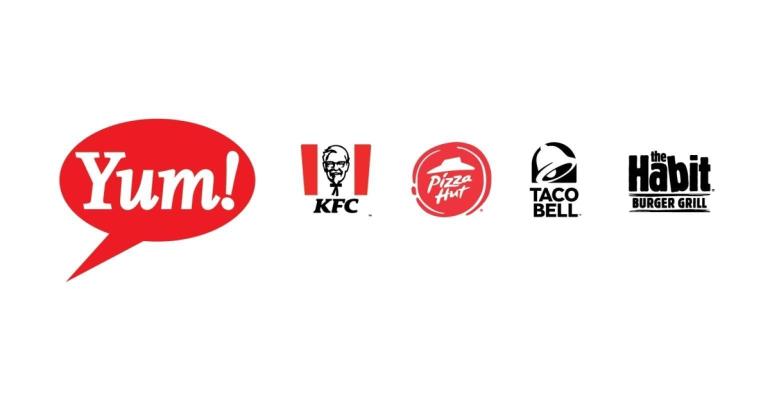A tech company that happens to sell (insert pizza, wings, salads here). We’ve heard this song before as executives – both past and present – from Domino’s, Wingstop and Sweetgreen have embraced their digital prowess at times more often than their actual menu offerings. And nothing against their menus, of course. It’s just that, traditionally, they’ve been a bit ahead of the curve in terms of tech stacks and such.
Yum Brands seems to have caught up, if Wednesday’s earnings call is any indication. The call included plenty of talk about digital sales and loyalty programs (next up, a KFC U.S. rollout) and kiosks (now in all Taco Bell U.S. locations) and so forth. There were also a few updates about the work Yum is doing to create operational efficiencies and leverage customer data to create more personalized experiences, which is quickly becoming a consumer mandate.
The pace at which this work is being tested and scaled is staggering, and to do both from a proprietary position is very likely a competitive advantage for the company. That proprietary journey became a bit more focused in 2019, when Yum launched its innovation function that eventually became the “Digital Innovation Lab.” According to CFO Chris Turner, Yum’s digital sales that year were about $12 billion. The company is now close to $30 billion. The company exceeded 40% in digital sales last year and is on a mission to get to 100% eventually.
“We like everything about those digital sales. Our customers have higher checks, higher frequency whenever we transition to digital. Plus, we get all the benefits of more efficient operations, which help our franchisees sustain strong unit economics,” Turner said during the company’s earnings call earlier this week.
This is why Yum has made strategic acquisitions in companies like Dragontail, which Yum acquired in September 2021 and which will be in about 8,000 global restaurants by the end of this year. The system leverages AI to automate the kitchen flow and optimize pickup and delivery times. This has also been the case with Kvantum, which Yum acquired in March 2021 to enhance the company’s ability to make “data-driven marketing decisions,” including marketing spend. And, this has been the case with Tictuk, which Yum also acquired in March 2021 to integrate conversational commerce through social media and messaging channels.
That said, this tech story has swiftly evolved since 2021, as is the nature of these applications. In June, Yum CEO David Gibbs hinted at more work with artificial intelligence and automation, and called AI a “big positive for the industry.” As revealed this week, Yum is now on track to have its Automated Inventory Management (AIM) system rolled out across the KFC U.S. system by the end of this year. The in-house developed AI module predicts and suggests the quantity of each product a GM should order, Turner said.
Yum is also testing a voice-enabled AI drive-thru system in a few California restaurants. Turner said the system has increased speed, productivity, and efficiencies, and also provides automated upsell recommendations. Additionally, the company is testing a proprietary automated drinks fulfilment system, which integrates into its proprietary point-of-sale platform. Turner said the automated drinks system frees up employees’ time at the drive-thru to speed things up.
Further, Yum is expanding its global data hub, which collects most of the company’s global transaction-level sales data and other metrics. Turner said the company will develop and test new AI capabilities – like personalized upselling recommendations and intelligent menu pricing recommendations – that “pull from the global data hub and integrate into our own technology platforms” in 2024.
It’s early days on some of these systems, but executives are bullish about the company’s strategy. As Gibbs noted in June, “We’re able to do lot of acquisitions of smaller companies that we can then scale that technology in our system. Our competitors can’t do that because they don’t have the ability to pay the same price for the acquisition and scale it across as many restaurants as we do, so this environment sets up for us to be the leader when it comes to proprietary technology in the restaurant industry.”
Yum has shifted an incremental 10 points of G&A expenses toward digital and technology throughout the last three years, Turner noted. Franchisees also have skin in the game and share in those investments via fees.
“They do that because they see benefits flow to their bottom line,” Turner said. “The business case on these technologies is strong.”
Consider loyalty, for instance. Taco Bell loyalty customers spend 40% more per year than traditional customers, executives said. The proprietary Poseidon POS system is another example of an ROI.
“As we start to layer the Poseidon POS, which makes running the front end easier as we continue to take digital sales higher, (it) reduces the workload burden on taking orders and payments. You get higher accuracy on order taking, which reduces some of the rework,” Gibbs said. “Then you bring on … voice AI at the drive-thru, (beverage) automation, you really start to see a vision for the future where you’ve got a really great customer experience with high productivity for franchisees.”
Contact Alicia Kelso at [email protected]





